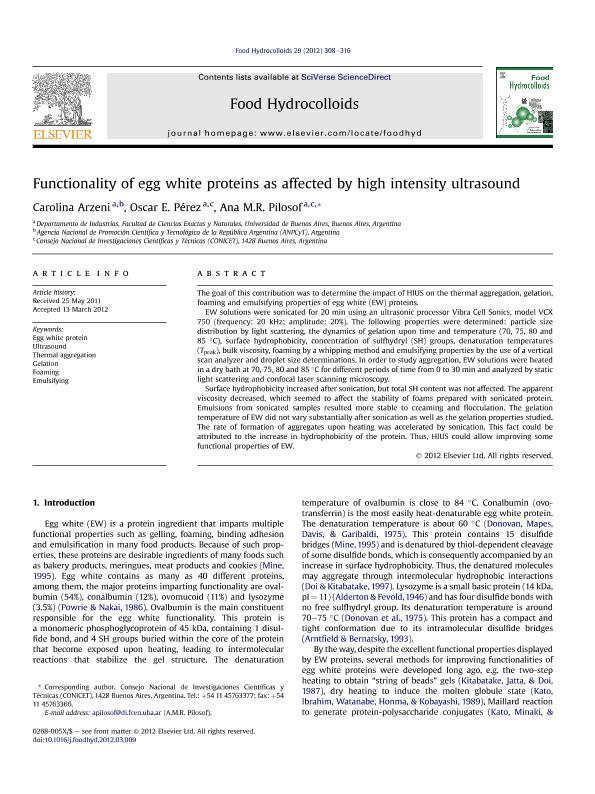Artículo
Functionality of egg white proteins as affected by high intensity ultrasound
Fecha de publicación:
12/2012
Editorial:
Elsevier
Revista:
Food Hydrocolloids
ISSN:
0268-005X
Idioma:
Inglés
Tipo de recurso:
Artículo publicado
Clasificación temática:
Resumen
The goal of this contribution was to determine the impact of HIUS on the thermal aggregation, gelation, foaming and emulsifying properties of egg white (EW) proteins.EW solutions were sonicated for 20 min using an ultrasonic processor Vibra Cell Sonics, model VCX 750 (frequency: 20 kHz; amplitude: 20%). The following properties were determined: particle size distribution by light scattering, the dynamics of gelation upon time and temperature (70, 75, 80 and 85 °C), surface hydrophobicity, concentration of sulfhydryl (SH) groups, denaturation temperatures (Tpeak), bulk viscosity, foaming by a whipping method and emulsifying properties by the use of a vertical scan analyzer and droplet size determinations. In order to study aggregation, EW solutions were heated in a dry bath at 70, 75, 80 and 85 °C for different periods of time from 0 to 30 min and analyzed by static light scattering and confocal laser scanning microscopy.Surface hydrophobicity increased after sonication, but total SH content was not affected. The apparent viscosity decreased, which seemed to affect the stability of foams prepared with sonicated protein. Emulsions from sonicated samples resulted more stable to creaming and flocculation. The gelation temperature of EW did not vary substantially after sonication as well as the gelation properties studied. The rate of formation of aggregates upon heating was accelerated by sonication. This fact could be attributed to the increase in hydrophobicity of the protein. Thus, HIUS could allow improving some functional properties of EW.
Palabras clave:
EGG WHITE PROTEIN
,
EMULSIFYING
,
FOAMING
,
GELATION
,
THERMAL AGGREGATION
,
ULTRASOUND
Archivos asociados
Licencia
Identificadores
Colecciones
Articulos(OCA CIUDAD UNIVERSITARIA)
Articulos de OFICINA DE COORDINACION ADMINISTRATIVA CIUDAD UNIVERSITARIA
Articulos de OFICINA DE COORDINACION ADMINISTRATIVA CIUDAD UNIVERSITARIA
Citación
Arzeni, Carolina; Perez, Oscar Edgardo; Pilosof, Ana Maria Renata; Functionality of egg white proteins as affected by high intensity ultrasound; Elsevier; Food Hydrocolloids; 29; 2; 12-2012; 308-316
Compartir
Altmétricas




